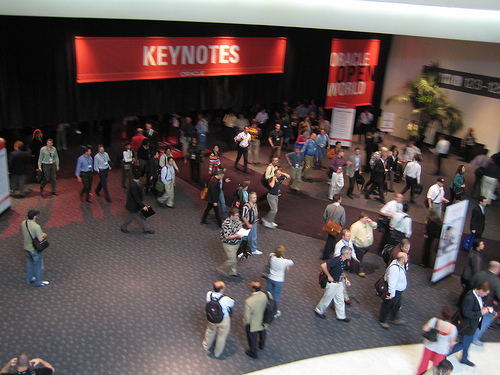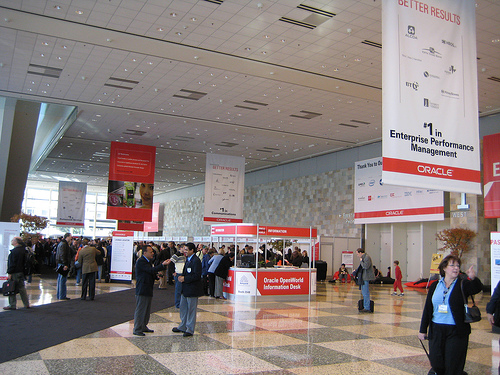OOW2007: Reflections on Oracle’s BI Strategy
'm currently sitting in a Starbucks just around the corner from the Hilton, waiting for my pick-up for the drive to SFO. One thing I like to try and do after a major conference like Open World is have a think about what the announcements and activity meant for the world of Oracle business intelligence and data warehousing, so with an hour or so to go before I leave now's a good time to jot some ideas down.

First of all, one thing that certainly jumps out at you is that BI, performance management and analytics was certainly one of the main themes of the conference. There were hundreds of business intelligence presentations, with a separate Hyperion stream, dozens of Oracle BI EE talks, BI keynotes and presentations on the new data warehousing and analytic features in the 11g release of the Oracle database. What's more, all of the main conference keynotes had business intelligence as a major component; Charles Phillips' talk features BI as part of the next range of Oracle ERP applications, Andy Mendelsohn's database keynote the new 11g release of Oracle OLAP and it's ability to replace large numbers of materialized views, whilst Larry Ellison's keynote introduced the first three fusion applications, all based around business intelligence and using the new Flex-based interface to deliver reports and data visualizations.
One thing that was a surprise was the amount of Hyperion customers at the various BI keynotes and sessions. Partly this is down to Oracle doing a good job of integrating Hyperion's EPM vision into Oracle's overall BI strategy, partly it's because so many of Hyperion's executives are now performing key roles and are driving much of Oracle's strategy, and partly it's because for Hyperion customers, what they use their tools for is not a "nice to have" but something that's critical for their business - if they get their reporting, consolidation and analysis wrong, their CFO could go to jail, for them it's important to engage with Oracle, ensure their products are supported and in time, enhanced, and they're particularly interesting in Oracle's new concept of integrating financial reporting with Oracle's previous strength, operational and transactional reporting.
This theme of integrating the worlds of financial and operational analysis into what Oracle term "Enterprise Performance Management" was certainly something that came out time and time again at the various BI sessions and keynotes. It's certainly an ambitious program but one that Oracle are uniquely positioned to execute on. Sessions such as Ed Suen's talk on the next-generation semantic layer that will be shared by both the Hyperion tools and Oracle's OBIEE platform, Dave Granholm's talk on the new features coming in the OBIEE Presentation Server, and the BI keynote were very useful in adding some "meat of the bone" to Oracle's integration and EPM strategy.

Apart from articulating the EPM strategy, the other main theme to the various BI sessions was to introduce some of the new features coming in Oracle BI Suite Enterprise Edition 11g. I must admit I was pretty taken-aback by what I saw; the user interface for Answers and Dashboard is going through a major overhaul, with a more task-based approach that makes it more obvious for users new to the tool how to go about key tasks - launch a dashboard, create a report, create a KPI. The major components are still there - Dashboard, Answers, Delivers - but these are likely to be complemented by a new scorecarding application, tools to manage goals and KPIs, and a new Action Framework that makes it simple to attach actions and activities to analysis provided by reports.
This Action Framework, for me, was the most exciting new feature in OBIEE 11g. Actions in 11g are first-class objects that reside in the web catalog, alongside requests, dashboards, alerts and so on, and represent calls to web services, java methods, workflow processes or similar, and can be attached to request columns so that they become available when you right-click on a data item. As a partner, this is a particularly interesting feature as I can imaging developing Actions that, for example, perform an action using Siebel CRM, Oracle E-Business Suite or in time, one of the new sales automation Fusion applications, which I can re-use on projects over and over again to deliver value for clients rapidly. Given the interest I've seen in even the rudimentary BPEL and SOA integration available in the current OBIEE release, I can see this framework becoming very popular with both customers and system integrators.
I managed to make it to a couple of Discoverer sessions, and it was interesting to me how the conversation has now moved on from questions around Discoverer's long-term future (it's assured, just like all the Apps Unlimited applications) to ones around migration, interoperability with OBIEE and how Discoverer can leverage tools like BI Publisher and Delivers. I also had a good look at the new Answers Plus tool (this is the project name, it'll probably still be called Answers in the new release). Answers Plus is the next generation of Oracle Answers, but now with OLAP functionality - however unlike Discoverer and Discoverer for OLAP, it's just the one tool that can leverage both relational and OLAP data sources using the one UI. For Discoverer customers reluctant to move to Answers currently due to it's lack of drilling, OLAP and analysis features, Answers Plus looks like just the ticket - like Discoverer relational, it's got all the drilling capabilities your used to, whilst like Discoverer Plus OLAP, it can make use of OLAP servers (through the BI Server semantic layer, allows step-based query generation, allows drilling using parent-child and ragged hierarchies, and the creation of report criteria using dimensional hierarchies and member selection. Very exciting stuff indeed.

For Hyperion customers, the urge to move isn't so apparent - Discoverer integration and migration plans are well established now, whereas the process of integrating Hyperion tools into the BI stack is fairly new and their customers' requirements are fairly specific - clearly the future around Hyperion is around plugging their back-ends into the OBIEE framework rather than wholesale replacement of the client applications, at least for the time being. One thing I did notice though was the prominence of Essbase in the various BI strategy talks - care was taken to equally position Oracle OLAP and Essbase as potential OLAP servers for the OBIEE platform, but over time it looks to me that Essbase will be the favoured OLAP server for the OBIEE platform, if only because it's cross-platform, already supports a huge amount of analytical apps with a lot of traction, and because it's so business-user friendly. Ironically though, Oracle OLAP has never been a better tool, arguably it's actually easier to use and set up than Essbase, offers the same sparse vs. dense cube storage options as Essbase but without the complications over different function sets between the two Essbase storage options. It'd be a shame if Oracle marketing pigeon-holed Oracle OLAP too much as just a data warehouse accelerator, but what's clear is that as an Oracle BI platform developer, you'll do well to learn Essbase as well as it will be the OLAP tool getting all the attention and focus at least from the Oracle BIEE platform team.
Another tool that did well out of Open World was Oracle Data Integrator. Ironically, I was too taken aback by the individual ODI presentations, but when you listed to people like Ed Suen talking about, in time, OBIEE "function-shipping" data transformation processes to ODI, the fact that ODI will in time complement Informatica as a supported ETL engine for the Oracle BI Apps, and that ODI ticks all the right architectural boxes (cross-platform, part of middleware, SOA and event-enabled) again it's clear to me that ODI, perhaps as part of some Oracle Data Integration Suite, is the strategic direction for Oracle in the data integration space.
Taking a step back through, and from conversations that I had with various people during the conference, one of the thoughts that are starting to become clear in my mind is that OBIEE is driving a step-change in Oracle's BI platform strategy, one that moves away from the time-intensive, IT skills intensive method of slowly building data warehouses on an Oracle data warehouse and then, eventually, delivering reports to users that hopefully meet their requirements and hopefully get delivered in time to make a business difference. What Oracle are driving at with OBIEE, together with ODI and Essbase, is the business user driving the BI development process with the OBIEE semantic layer, coupled with the analysis requirements of the user, then driving the creation of data mappings, creation of data marts and data warehouses, storage of data in relational or performance-optimized OLAP cubes, with an emphasis on delivering business value as soon as possible and relegating the "techy-bits" of how to store data, what sort of storage engine to use, how best to physically integrate data, to a kind of "automated process".
If you take the view that creating a data warehouse using a dimensional model, optionally storing part or all of it in an OLAP server, and either transforming data in real-time or using an ETL tool like ODI, is a kind of "solved problem" that can eventually be automated and driven off the back of business requirements, you can see a future where BI gets delivered faster, is more in-tune with business requirements, is more agile and spends less time bogged down with re-inventing the "data warehouse design wheel", in the future it'll be the semantic model that's the key part of the BI architecture, everything else is just a design detail and something that can be generated based off of design best practices. Interested stuff indeed.
Overall, this is indeed a very interesting time to be in Oracle BI and data warehousing, but it's also a challenging time and one where you'll do well to challenge the traditional ways of running a project, using technology and delivering business value. The tools will be in place soon to drive the creation of a BI infrastructure from the front, based on business requirements and intelligent automation processes, and the future of BI is increasingly around integrating tightly the worlds of financial and operational analysis, and business insights and business actions. Oracle have got some very smart people running their BI strategy, and the incorporation of Hyperion has added a particularly smart business focus to their technical ability. Certainly Oracle are in a unique, advantaged position in the BI industry, it'll be interesting to see how they execute on their strategy over the next twelve months and how some of this vision starts to take place.
That's it for Open World and San Francisco for me now; the cab arrives in half an hour or so, I've got the presents for Janet and the kids, in a few hours it'll be case of relaxing on the plane and preparing my next article, an in-depth look at the 11g release of Oracle OLAP.